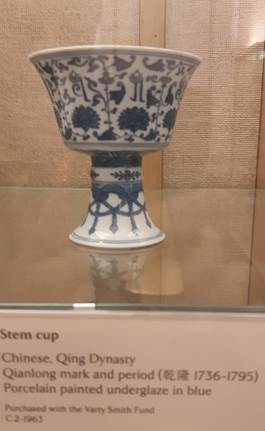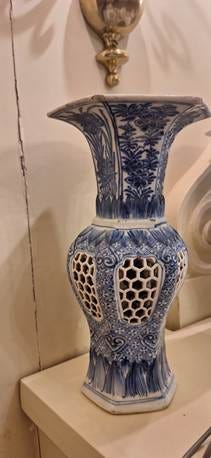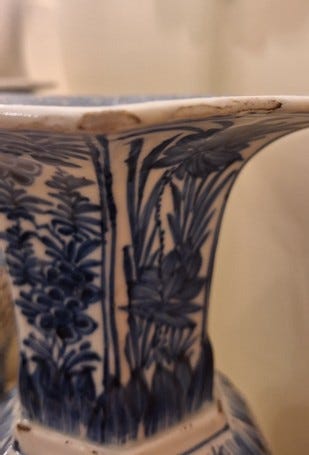Last week’s post about tea introduced the whole subject of pottery and Henrietta Howard’s love of chinaware.
Chinese ceramics are, of course, beautiful, but nowadays they are just one option when you want some nice pottery. Back in 1700, though, there was nothing else remotely as good.
Thanks for reading Tom’s Substack! Subscribe for free to receive new posts and support my work.
Henrietta was almost obsessive in her collecting of chinaware. By the time of her death, she had so much that the normally meticulous inventory clerks of the time were reduced to noting “it was not Possible to Take an Inventory of the China”. Perhaps her enthusiasm was a reaction against the earthenware she grew up with as a young girl in Norfolk. This mug in the Fitzwilliam museum in Cambridge is hardly a thing of beauty.
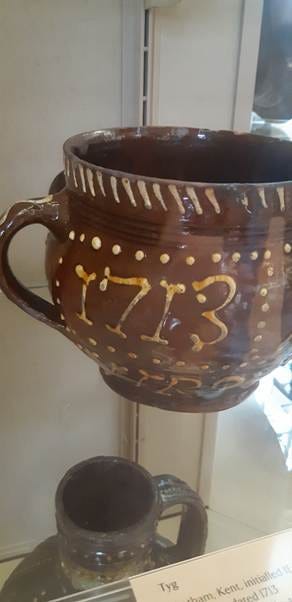
Compare that with what the Chinese were producing at about the same time.
Chinese porcelain was better than anything produced in Europe because of the material that it was made out of (a compound of petunste and kaolin called ‘hard paste’) and the very high temperatures it was fired at – temperatures higher than European furnaces could reach. This produced very thin, white, glazed pottery.
The Dutch were the first European country to reproduce the brilliant white glaze of chinaware by covering their pottery (usually reddish earthenware) with a lead glaze to which has been added tin oxide. Delft was a major centre for the production of the finest Dutch pottery which became known as Delftware. It became very popular and there is a lot of it on display at Marble Hill House where it is, at first glance, easily confused with chinaware.

With these particular pieces, the clearest indication that they are European is that the scenes, although painted in a Chinese style feature Dutch architecture.
Not that the presence of European architecture is definitive, as the Chinese did produce European scenes on some Chinaware intended for the export market. It can be particularly difficult to distinguish Chinese production from Delftware because, as the European market became more important to the Chinese, they produced pottery that looked like Delftware alongside chinaware. The items shown below (all from the V&A in London) were made in China for the export market. The coffee pot (5) imitates a Dutch coffee pot while the figure of a Dutchman (7), although made in China, was decorated in the Dutch Republic.
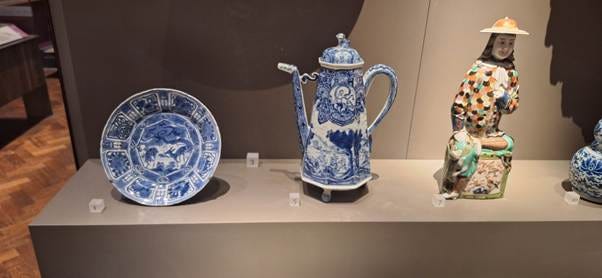
How can you tell true Chinaware from Delftware or early European porcelain made with clay-based mineral mixes collectively known as ‘soft paste’ to distinguish them from the Chinese hard paste mix?
Hard paste porcelain is stronger and less likely to break. When it does break, the porcelain is white below the glaze, while Delftware is more likely to chip and the chips will reveal the darker clay mixture beneath the glaze. You can see this on the Delftware at Marble Hill.
Because Chinaware is stronger it can be made much thinner. Chinaware is typically lighter and more delicate in appearance. It is also translucent.
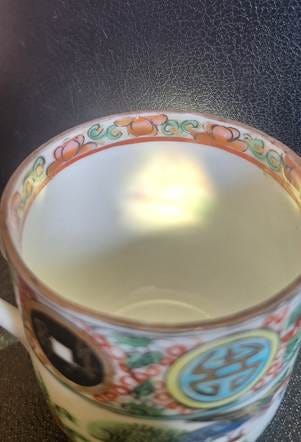
Some soft paste porcelain will also allow some light through but it will be less sharply defined.
Once European manufacturers worked out how to make hard paste porcelain, they began to experiment with ways to improve it. Late in the 19th century, a Staffordshire potter, Josiah Spode, added ground bone meal to hard paste to develop “Staffordshire bone-porcelain”, which was even stronger than traditional Chinese porcelain. By the end of the Napoleonic Wars, all the major English factories were producing bone china.
Until late in the 20th century, bone china was almost exclusively an English product, with production centred on Stoke-on-Trent, an area that became known as “the Potteries” where it was made by firms like Spode, Royal Worcester, Royal Crown Derby, Royal Doulton, and Wedgwood. Gradually, it began to be manufactured elsewhere until today it is once again mainly produced in China.

